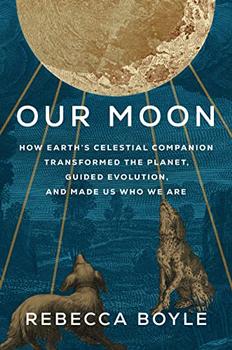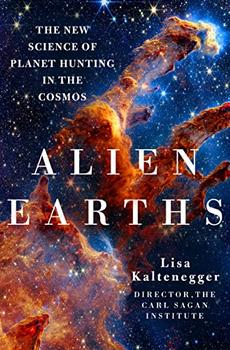Summary | Excerpt | Reviews | Beyond the book | Read-Alikes | Genres & Themes | Author Bio

How Earth's Celestial Companion Transformed the Planet, Guided Evolution, and Made Us Who We Are
by Rebecca BoyleIn Our Moon: How Earth's Celestial Companion Transformed the Planet, Guided Evolution, and Made Us Who We Are, author Rebecca Boyle explains how Earth's closest neighbor is essential to our history. Reliable and mythical, epic in size and significance, the Moon has been profoundly influential since the beginning. According to Boyle's extensive research, we would not be here without it.
She begins by recounting theories of the Moon's creation, all involving a collision of some kind with Earth, and how it shaped our planet with its tides, with its light and lack of light. She explains how the earliest terrestrials used it to navigate at night and to time their reproductive cycles. As our planet evolved, countless species learned to "sync their mating, feeding, and spawning schedules with the phases of the Moon." Coral reproduction is entirely dependent on the full Moon each month. It's suspected the Moon influences human biology and fertility as well. "Humans have long assumed that the Moon affects us," Boyle writes. After all, "the words 'lunacy' and 'lunatic' derive from it."
With plenty of footnotes and numbered resources, Boyle weaves many tales, depicting the Moon's complex history through the eyes of those who held it in personal high esteem. From the earliest Moon worshippers like Babylon's Ennigaldi-Nanna, circa mid-500s BCE, and the city of Ur, dedicated to Sumerian Moon god Nanna, we witness the Moon shape burgeoning mythology and religion: "In endowing us with religion, the Moon taught humans both a new means of control and a new form of thinking. The Moon would bring our ancestors closer to a full understanding of the celestial bodies, and of the world around them."
From farmers and rulers tracking lunar cycles, we learn how crucial the Moon was for agriculture and how time-keepers like Caesar held great power. Through stories of significant scientists and philosophers, we see art progress with a telescope. Thomas Harriot and Galileo Galilei sketched the earliest representations of the lunar surface; Johannes Kepler wrote arguably the first science fiction story, Somnium, after studying the Moon's craters and inventing a race of Moon-dwellers, the Levanians. He used it to illustrate his then-radical theory that the Earth wasn't the center of the universe.
Our Moon is a well-suited first book for journalist Boyle, who's a regular contributor to Atlas Obscura and has a personal obsession with the Moon. Who better to examine the Moon's importance than a mega fan? Boyle shares her childlike wonder with relish. Many footnotes offer home-based experiments, and she also takes the reader on Moon-related field trips.
In Scotland she visits the famed Warren Field, "which sits atop the ruins of the world's oldest known lunar calendar." Dated 8,000 BCE, "It was made from a series of pits in the ground in a field adjacent to a fifteenth-century castle in Aberdeenshire." Scotland's rugged landscape is also marked by stone circles believed to be associated with lunar cycles or worship. Included is a wonderful collection of photographs depicting these monuments and others.
Boyle also examines bits of the Moon we've brought back to Earth. She visits a space lab in Texas, where she's suited up and sanitized before entering a room full of lunar fragments. Here she learns just how similar the Moon's surface is to ours — "Earthy" in texture and makeup. Rocks brought back from the first Apollo mission proved that both were once covered in molten lava.
The dance of the Earth and Moon holds eternal appeal because it is so tied to our existence. "If you are inclined to think about the nature of things, how the cosmos is arranged, and what it all means, the Moon will always be an interesting subject. It exists in a realm apart from Earth but is clearly inseparable from Earth. Its appearance changes every night, but it always returns."
The Moon continually astonishes us, and for something so intertwined with the human saga, this makes perfect sense. We are curious and always wondering. Fascination is simply in our nature.
![]() This review
first ran in the February 21, 2024
issue of BookBrowse Recommends.
This review
first ran in the February 21, 2024
issue of BookBrowse Recommends.

If you liked Our Moon, try these:

by Lisa Kaltenegger
Published 2025
Riveting and timely, a look at the research that is transforming our understanding of the cosmos in the quest to discover whether we are alone.

by Samantha Harvey
Published 2024
A slender novel of epic power, Orbital deftly snapshots one day in the lives of six women and men hurtling through space - not towards the moon or the vast unknown, but around our planet.
Your guide toexceptional books
BookBrowse seeks out and recommends the best in contemporary fiction and nonfiction—books that not only engage and entertain but also deepen our understanding of ourselves and the world around us.